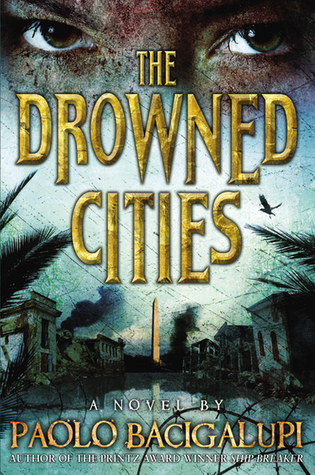
By Paolo Bacigalupi
(Little, Brown)
Whether it’s a conscious or subliminal reaction to U.S. military involvement in Iraq and Afghanistan, war is an increasingly common theme in modern young adult literature. But its horrors are rarely so thoroughly detailed as in Paolo Bacigalupi’s “The Drowned Cities.” One of the more graphically violent young adult titles of late, “The Drowned Cities” reads like a dystopian mash-up of the Vietnam War and modern geopolitics, where survivalism battles personal loyalties in a chaotic world.
Suzanne Collins may have put dystopian literature on the YA map with “The Hunger Games,” but Bacigalupi is one of the genre’s masters, employing inventively terrifying details in equally imaginative story lines. About half of the “The Drowned Cities” takes place in the same flooded cityscape as Bacigalupi’s young adult debut, “Ship Breaker,” which won the prestigious Michael L. Printz award last year and was also nominated for a National Book Award. Both novels share themes of scavenging and survival in an environmentally degraded future, but the titles are otherwise unrelated, with entirely different characters and quests.
“The Drowned Cities” opens with a festering prison scene. A genetically engineered killing machine named Tool is rotting behind bars, until a jailer unlocks the gate and unleashes him into the wild. This fusion of tiger, dog, hyena and man is not the main protagonist but the sidekick to an orphan, Mahlia, who helps heal the monster’s wounds.
Mahlia is an unlikely medic. Her right hand was macheted off by laughing soldiers during a war that’s been raging for at least a decade. Mahlia shouldn’t have survived the attack, but she was saved by a stranger she calls Mouse who has since become a surrogate family member for her. Mahlia, Mouse and Tool form an uneasy alliance that really captures the distrust and unusual loyalties that conflict inspires.
The war in “The Drowned Cities” is a multi-faceted battle among religious warriors, freedom fighters, a ragtag army known as the UPF and remnants from a group called the Peacekeepers who clearly failed at their job. While the groups and their motivations are difficult to understand entirely, they cause Mahlia and Mouse to become separated. Most of the book is about the two trying to find each other, though the relationship is not romantic. The environment is too hostile.
“The Drowned Cities” is not for the faint of heart or possibly even for readers at the lower end of the recommended reader age spectrum. It is far more violent even than “The Hunger Games” conclusion, “Mockingay.” The action is oftentimes barbaric. Amputations are common. Even more bodies pile up as a result of atrocities committed with acid and, of course, guns. Many of the book’s minor characters delight in torturing their victims, pouring flesh-eating chemicals down bare-skinned backs and smashing their faces into the dirt. At one point Mahlia notes that surviving only creates more killing.
The majority of the characters are young. The uncivilized world in which they live is too horrific for many of them to grow old. Books are mostly used to start fires that are kept going with broken furniture and oil paintings. Meals consist of ant eggs, grasshoppers, crawdads and random carrion.
Much of the action takes place in and around Washington, but the city is never identified as such. Bacigalupi does a “Planet of the Apes”-style reveal of key details that let readers know this barely recognizable landscape was at one time our nation’s capital. Its streets were flooded long ago, turning them into canals choked with algae. The Capitol is little more than a target for looters and scavengers who trade pieces of its marble facade and copper wiring for bullets, loading their loot onto biodiesel skiffs that float up to the entrance.
The Chinese recently occupied the land that has become so disassociated from the United States that it’s referred to as only “the long dead nation.” Its currency, issued by the Beijing Banking Corp, is written in English and Chinese. Simultaneously fascinating and terrifying, “The Drowned Cities’” overall story line isn’t as novel as “Ship Breaker,” but Bacigalupi’s imaginative detailing of the chaos that ensues when modern technologies collide with human desperation in a degraded landscape is powerful. (MCT)
-
Articles by Korea Herald










![[Hello India] Hyundai Motor vows to boost 'clean mobility' in India](http://res.heraldm.com/phpwas/restmb_idxmake.php?idx=644&simg=/content/image/2024/04/25/20240425050672_0.jpg&u=)









